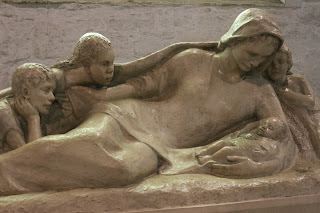Banner was also an Anglican lay priest, and he led her to be baptised into the Anglican church, a faith that has run through much of her artistic work. Among her works outside Cumbria are ‘Reconciliation’ at Coventry Cathedral and Bradford University, ‘Holy Family’ at Liverpool Cathedral and Gloucester Cathedral, ‘Mary and Child’ at St Paul’s Cathedral, London, ‘Nativity’ (at Christmas) at St Martin-in-the-Fields Church in Trafalgar Square, London (now destroyed), and many more.
In Cumbria she received commissions for 13 different locations, many of which were churches. I have recently seen sculptures by de Vasconcellos at Kendal Parish Church and Cartmel Priory.
The Family of Man is in the South Aisle at Kendal Parish Church. The setting for this sculpture is a contemporary Refugee Camp in the Middle East. Huddled together, under an old blanket are Mary, Jesus and three children representing the African, European and Oriental peoples of the world. Although it has the appearance of stone the sculpture, like much of de Vasconcellos' work, is made of fibreglass. As a result, it is sometimes moved elsewhere in the church.
At Cartmel Priory, on entering the charming little chapel known as the town choir, de Vasconcellos' sculpture of St Michael the Archangel battling his way through the jaws of the dragon is powerfully evident. In the sedilla in the wall opposite is 'The True Vine' depicting the Virgin Mary and the baby Jesus. 'The Young Martyr' in the North Transept commemorates the four canons and ten laymen executed in 1537 for resisting the closure of Cartmel Priory during the dissolution of the monasteries, and for all martyrs who have died for their faith. On one of the sides the names of the Martyrs of Cartmel from 1537 are carved into the stone. Within the base of a solid stone plinth is a lighted candle in a red glass holder. Topping the sculpture is a head behind solid bars. 'They fled by night – Mary and Joseph and the Holy Child' is a very tactile statue being only a few feet high and made of solid resin bronze so, as many before you have done, you can pass your hands over the work easily without risk of damage. De Vasconcellos has captured a moment when the holy family rested in the desert on their flight into Egypt. St Michael
At Cartmel Priory, on entering the charming little chapel known as the town choir, de Vasconcellos' sculpture of St Michael the Archangel battling his way through the jaws of the dragon is powerfully evident. In the sedilla in the wall opposite is 'The True Vine' depicting the Virgin Mary and the baby Jesus. 'The Young Martyr' in the North Transept commemorates the four canons and ten laymen executed in 1537 for resisting the closure of Cartmel Priory during the dissolution of the monasteries, and for all martyrs who have died for their faith. On one of the sides the names of the Martyrs of Cartmel from 1537 are carved into the stone. Within the base of a solid stone plinth is a lighted candle in a red glass holder. Topping the sculpture is a head behind solid bars. 'They fled by night – Mary and Joseph and the Holy Child' is a very tactile statue being only a few feet high and made of solid resin bronze so, as many before you have done, you can pass your hands over the work easily without risk of damage. De Vasconcellos has captured a moment when the holy family rested in the desert on their flight into Egypt. St Michael
-------------------------------------------------------------------------------------------------
Norman Nicholson - Silecroft Shore.













No comments:
Post a Comment